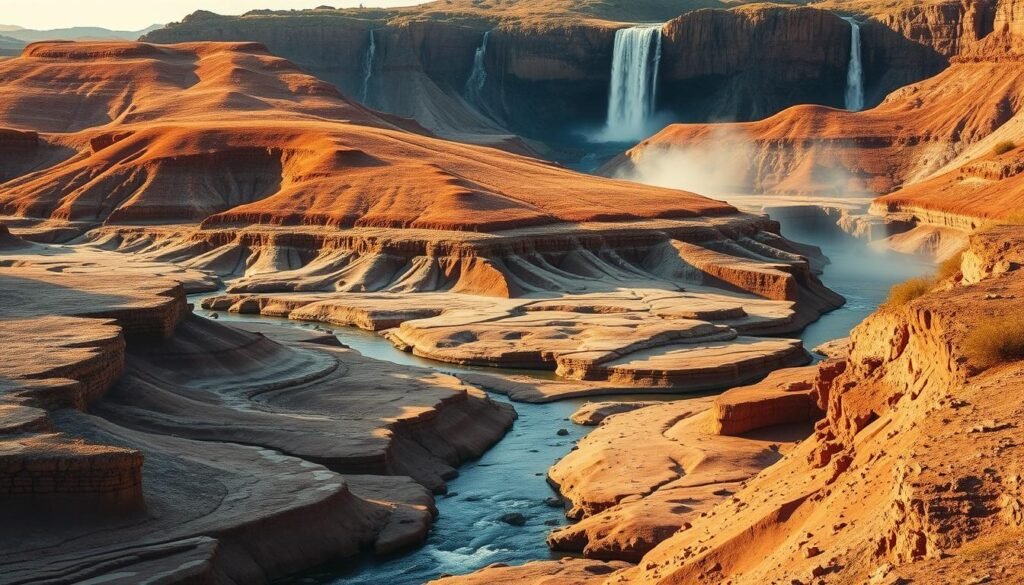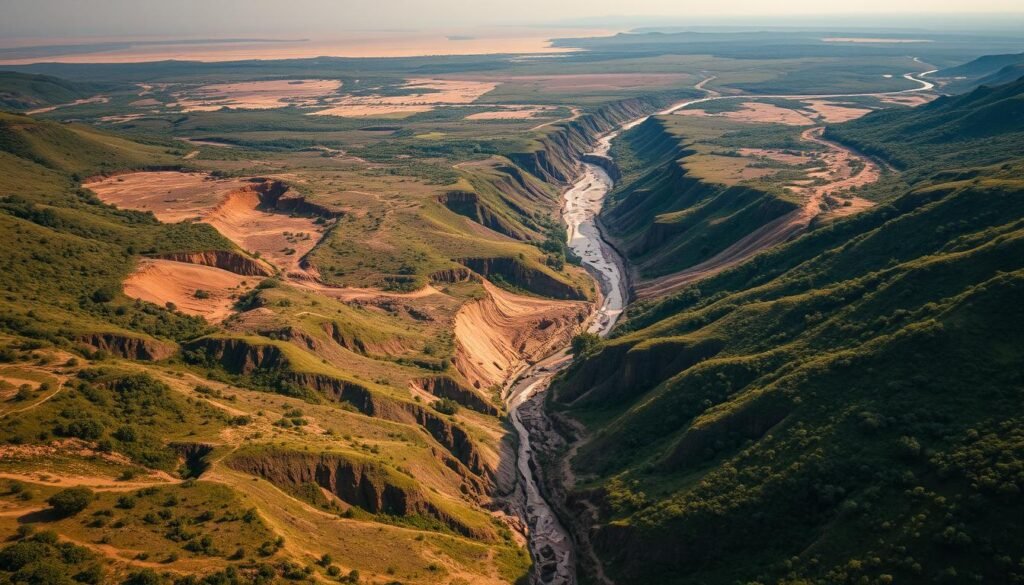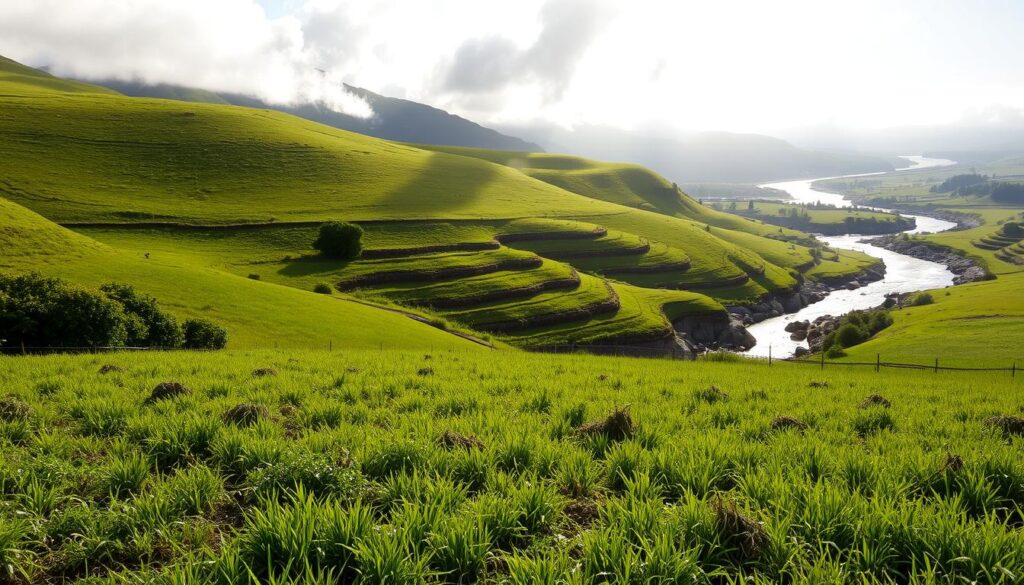Is the loss of fertile land a ticking time bomb for global food security? Soil erosion due to water flow is a big problem. It hurts farming and can ruin the land.
The damage to farmland is huge. It makes crops grow less and the land less fertile. When water moves over the land, it takes away the topsoil. This is a big danger to our environment and farming.
Key Takeaways
- Understanding the causes of water erosion is crucial for prevention.
- Erosion control measures can significantly reduce land degradation.
- Effective erosion prevention strategies can protect agricultural land.
- Soil erosion has severe impacts on farmland productivity.
- Implementing sustainable practices can mitigate the effects of erosion.
What Is Water Erosion and Why It Matters
Knowing about water erosion is key to protecting our environment. It happens when water takes away the topsoil. This can happen naturally or because of human actions.
Definition and Natural Processes
Water erosion is a natural process that has changed landscapes for millions of years. It happens when rain or runoff moves soil away. Things like rainfall intensity, soil composition, and terrain slope affect it.
The natural steps in water erosion include soil particles being detached by rain and then moved by runoff. Knowing these steps helps us find ways to lessen water erosion’s bad effects.
The Erosion Cycle Explained
The erosion cycle has stages like detachment, transportation, and deposition. The erosion cycle is shaped by things like rainfall, soil type, and how we use the land. It’s important to manage the erosion cycle well to stop soil degradation and keep soil healthy.
Good erosion management plans can lessen water erosion’s harm. These plans include using conservation tillage, terracing, and planting trees to keep soil in place and lower erosion risk.
Common Types of Water Erosion
Knowing about water erosion types is key for taking care of the land. Water erosion shows up in many ways, each affecting the land differently.
Sheet Erosion: The Silent Threat
Sheet erosion quietly takes away a layer of soil. It’s often not seen until it’s too late.
Rill Erosion: Formation and Progression
Rill erosion happens when water flows into small channels. These channels can grow bigger and deeper if not stopped.
Gully Erosion: Severe Land Degradation
Gully erosion is when big channels or gullies form. It can change the land a lot and make it hard to use.
Stream Bank Erosion: Waterway Damage
Stream bank erosion happens along rivers and streams. Water erodes the banks, causing land loss and harming habitats.

| Type of Erosion | Characteristics | Impact |
|---|---|---|
| Sheet Erosion | Uniform soil removal | Loss of fertile topsoil |
| Rill Erosion | Formation of small channels | Visible damage, potential for gully formation |
| Gully Erosion | Large channels or gullies | Severe land degradation, loss of land |
| Stream Bank Erosion | Erosion along waterways | Loss of land, habitat destruction, increased sediment |
Each type of water erosion needs its own way to prevent and control it. Knowing the differences helps us fight its effects.
Key Factors Causing Water Erosion
Many things cause water erosion. Knowing these helps us figure out erosion risk. It also helps us find ways to stop it.
Rainfall Patterns and Intensity
Rainfall is a big factor in water erosion. Heavy rain can make more water run off, leading to erosion. Places with lots of rain are more likely to erode because of the fast-moving water.
Soil Composition and Vulnerability
Soil type affects how much it erodes. Soils with lots of sand or no organic matter erode easily. Knowing about soil helps us find and protect risky areas.
Terrain and Slope Considerations
The shape of the land also matters. Steeper areas erode more because water flows faster. Hills, valleys, and rivers can make erosion better or worse.
In short, to understand erosion risk, we need to know about rain, soil, and land shape. This helps us find and fix places at risk of erosion.
Human Activities Accelerating Erosion
Human actions make water erosion worse. Removing plants, farming hard, and building things harm the land. This makes erosion more likely.
Deforestation and Vegetation Removal
Removing trees and plants causes a lot of erosion. Without plants, soil can’t stay put. Trees and plants keep the soil in place.
Agricultural Practices and Their Impact
Farming hard can lead to more erosion. Monoculture farming and heavy machinery hurt the soil. But, using crops in rotation and planting cover crops can help.
Construction and Land Development Effects
Building and changing the land makes it more likely to erode. Good planning and erosion control can lessen this problem.
Knowing how human actions affect erosion is key. We can fight erosion by managing land better. This protects our natural resources.
Environmental Consequences of Water Erosion
Water erosion hurts the environment a lot. It changes soil, water, and plants. It makes ecosystems worse in many ways.
Soil Degradation and Fertility Loss
Soil gets worse when water erodes it. Topsoil, where plants grow, is lost. This makes plants grow less well.
Soil erosion can lose the top 5-10 cm of soil. This part has most of the soil’s nutrients.
| Soil Characteristic | Effect of Erosion | Consequence |
|---|---|---|
| Soil Fertility | Loss of Nutrient-Rich Topsoil | Reduced Agricultural Productivity |
| Soil Structure | Increased Sedimentation | Waterway Obstruction |
| Soil Organic Matter | Decreased Soil Health | Increased Greenhouse Gas Emissions |
Water Quality Deterioration
Water erosion also hurts water quality. Runoff carries sediments and pollutants. This makes water dirty and harms fish.
Experts say, “Sediments in water harm fish and make water treatment more expensive.”
“Erosion and sedimentation are among the most significant threats to water quality, impacting both human health and the environment.”
Habitat Destruction and Biodiversity Loss
Water erosion also destroys homes for plants and animals. Sediments cover water homes. Less plants mean less homes for animals.

We need to stop erosion to save our planet. Knowing how erosion hurts us helps us protect nature.
Economic and Social Impacts of Erosion
Water erosion does more than harm the environment. It also affects our economy and social life. It changes many parts of our lives and the economy.
Agricultural Productivity Decline
Water erosion hurts agricultural productivity a lot. It makes the soil less fertile, which means less land for crops. This hurts farmers and makes food harder to find.
John Doe, an agricultural expert, says, “Soil erosion quietly kills crops. If we don’t stop it, it will hurt our economy a lot.”
Infrastructure Damage and Repair Costs
Water erosion also damages infrastructure like roads and bridges. Soil erosion can make these structures unstable and break them. This means we have to spend a lot to fix them.
A study found that fixing erosion damage costs millions each year. It says, “Erosion’s cost to our infrastructure is huge and keeps growing if we don’t act.”
Community and Property Value Effects
Water erosion also hurts communities and property values. It makes neighborhoods look bad and lowers property values. This makes it hard for people to sell their homes and hurts local businesses.
“Erosion control is not just an environmental issue; it’s also an economic and social imperative.”
This quote shows why we must fight erosion to keep our communities safe.
How to Assess Erosion Risk on Your Property
To keep your property safe from water erosion, you need to check the risk. This means knowing what makes erosion happen on your land.
Identifying High-Risk Areas
High-risk spots often have steep slopes, little plants, or are close to water. Water flows easily here, making erosion more likely. “Spotting these areas is key to fighting erosion,” says a land expert.
Performing a Basic Erosion Assessment
Start by looking for signs of erosion like rills, gullies, or sediment deposits. Think about your soil, how much rain you get, and how you use the land. This helps figure out how bad the erosion risk is.
When to Seek Professional Evaluation
If you’re not sure about your property’s erosion risk or if it’s high, get a pro to check it. They can give a detailed report and suggest erosion prevention methods just for your place.
By doing these things, you can manage erosion risk well. This keeps your land safe from water erosion’s harm.
Practical Water Erosion Prevention Techniques
There are many ways to stop water erosion. You can use simple plants or more complex methods. These include structural and management strategies.
Vegetative Solutions: Plants and Ground Covers
Planting is a great way to stop erosion. Plants and trees keep the soil in place. Their leaves also soak up rainwater, stopping it from running off.
Native plants are especially good. They fit well in their environment and need little care.
Structural Methods: Barriers and Diversions
Building barriers or diversions can also help. You can make retaining walls, diversion ditches, or use riprap. These protect slopes and waterways.
Land Management Strategies: Tillage and Terracing
Practices like conservation tillage and terracing help a lot. They reduce soil disturbance and make areas level. This cuts down on runoff.
Water Management Approaches: Drainage and Retention
Good water management is key. Use drainage systems and retention ponds. They manage water flow and stop too much runoff.
Implementing Rain Gardens
Rain gardens are shallow areas with plants. They catch and filter rainwater. This reduces runoff and stops erosion.
Creating Swales and Berms
Swales and berms manage water flow. Swales are shallow ditches that filter water. Berms are raised barriers that direct water. Together, they prevent erosion.
| Technique | Description | Benefits |
|---|---|---|
| Vegetative Solutions | Planting vegetation to hold soil in place | Reduces runoff, stabilizes soil |
| Structural Methods | Constructing barriers or diversions | Controls water flow, protects infrastructure |
| Land Management | Conservation tillage and terracing | Minimizes soil disturbance, reduces runoff |
| Water Management | Drainage systems and retention ponds | Manages water flow, prevents excessive runoff |
Using these techniques can stop water erosion. This protects the land and nearby waterways.
Conclusion: Protecting Your Land from Water Erosion
Keeping land safe from water erosion is very important. It helps keep the soil and water clean. It also helps animals and plants live well together.
Water erosion can harm the environment, cost money, and affect people’s lives. We need to know and act to stop erosion. This way, we can keep the land safe for our children and grandchildren.
To stop erosion, we use plants, walls, and smart land use. Knowing why and how erosion happens helps us protect our land. Using methods like terracing and managing water flow can really help.
Working to save land from erosion is key to keeping nature healthy. It also helps farms grow food better. By working together, we can all help protect our planet and its resources.
